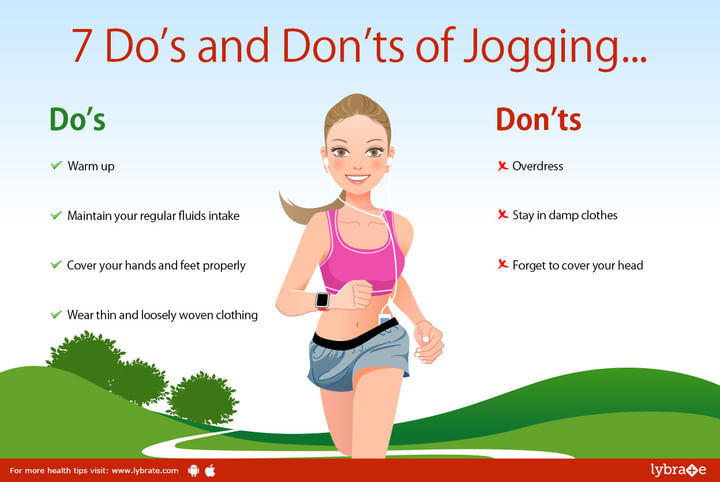Get the App
For Doctors
Login/Sign-up
Last Updated: Aug 29, 2019
BookMark
Report
7 Do’s and Don’ts of Jogging
7 Do’s and Don’ts of Jogging
Exercises like jogging give great benefits during the cold weather, provided they are done in the correct way. Jogging not only keeps you active throughout the day by increasing your energy level, but also helps you in maintaining your shape even if you consume some extra calories when the weather is relatively pleasant or colder than usual like it is during winters. Read on to find out the do’s and don’ts of jogging.
Do’s
1. Wear thin and loosely woven clothing
Opt for clothes made of thin synthetic material while jogging. This is because this type of material is beneficial in absorbing the sweat from your body. Additionally, you can wear an outer layer of nylon, to ensure that you remain protected from the wind and precipitation, besides maintaining the heat balance of your body. Never wear cotton while jogging as it does not absorb sweat and leaves you with a wet feeling.
2. Cover your hands and feet properly
The heat possessed by your body escapes mostly through your hands and feet (as much as 30% of heat is released by them). So, make sure to cover your hands and feet with running gloves and socks during jogging when the cold is mild, and with mittens when the temperature further decreases. Wear wicking sock liners underneath your woollen socks to soak the moisture generated while running.
3. Maintain your regular fluids intake
Irrespective of the type of weather, your body loses fluids in the form of sweat while jogging. In addition to this, the chilly air of the winter increases the chances of dehydration. So, keep yourself hydrated during, before and after jogging by drinking enough water or sport drinks.
4. Warm up
It is necessary to stretch out a bit before jogging to wake up your tired muscles. So, before starting your daily jogging regime make sure that you get a bit of physical activity.
Don’ts
1. Stay in damp clothes
Getting wet from rain or sweat while jogging on a cold day, increases your chances of developing hypothermia by decreasing the body temperature further. Immediately change your clothes if they are wet and turn on your heater to warm yourself.
2. Overdress
Never dress in a way that makes you feel warm and comfortable before starting to jog. This is going to make you feel warmer as your movements increase, and in turn results in more sweating or discomfort.
3. Forget to cover your head
It may be an astonishing fact, but your body actually loses 40% of its heat through the head. So, never make the mistake of leaving your head bare before stepping outside to jog in the winter. You can wear a hat, woollen cap or a scarf during this time to protect your head.
CAUTION: Jogging at a slower pace is a low impact exercise as compared to running. Research has shown that jogging at slow speed is better than running because of lower impact on foot, ankle, knee and hip joints. However if you have any medical conditions then you should discuss with your medical practitioner to know if jogging is safe for you.
Exercises like jogging give great benefits during the cold weather, provided they are done in the correct way. Jogging not only keeps you active throughout the day by increasing your energy level, but also helps you in maintaining your shape even if you consume some extra calories when the weather is relatively pleasant or colder than usual like it is during winters. Read on to find out the do’s and don’ts of jogging.
Do’s
1. Wear thin and loosely woven clothing
Opt for clothes made of thin synthetic material while jogging. This is because this type of material is beneficial in absorbing the sweat from your body. Additionally, you can wear an outer layer of nylon, to ensure that you remain protected from the wind and precipitation, besides maintaining the heat balance of your body. Never wear cotton while jogging as it does not absorb sweat and leaves you with a wet feeling.
2. Cover your hands and feet properly
The heat possessed by your body escapes mostly through your hands and feet (as much as 30% of heat is released by them). So, make sure to cover your hands and feet with running gloves and socks during jogging when the cold is mild, and with mittens when the temperature further decreases. Wear wicking sock liners underneath your woollen socks to soak the moisture generated while running.
3. Maintain your regular fluids intake
Irrespective of the type of weather, your body loses fluids in the form of sweat while jogging. In addition to this, the chilly air of the winter increases the chances of dehydration. So, keep yourself hydrated during, before and after jogging by drinking enough water or sport drinks.
4. Warm up
It is necessary to stretch out a bit before jogging to wake up your tired muscles. So, before starting your daily jogging regime make sure that you get a bit of physical activity.
Don’ts
1. Stay in damp clothes
Getting wet from rain or sweat while jogging on a cold day, increases your chances of developing hypothermia by decreasing the body temperature further. Immediately change your clothes if they are wet and turn on your heater to warm yourself.
2. Overdress
Never dress in a way that makes you feel warm and comfortable before starting to jog. This is going to make you feel warmer as your movements increase, and in turn results in more sweating or discomfort.
3. Forget to cover your head
It may be an astonishing fact, but your body actually loses 40% of its heat through the head. So, never make the mistake of leaving your head bare before stepping outside to jog in the winter. You can wear a hat, woollen cap or a scarf during this time to protect your head.
CAUTION: Jogging at a slower pace is a low impact exercise as compared to running. Research has shown that jogging at slow speed is better than running because of lower impact on foot, ankle, knee and hip joints. However if you have any medical conditions then you should discuss with your medical practitioner to know if jogging is safe for you.



+1.svg)
